You don’t need to be a diver to explore Australia’s incredible ship graveyard
By Andrew Bain
In the waters off a Queensland island, a cloud of fish gathers around me as though I’m one of the shoal. They come in all colours, sizes and shapes: silver fish that glisten like constellations, tiny fish as blue and bright as the cloudless sky, Moorish idols with their fins trailing like streamers.
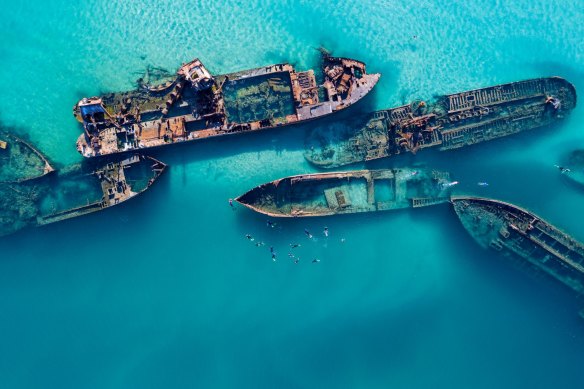
Snorkeller’s paradise: the submerged wrecks off Tangalooma Beach.Credit: Keiran Lusk
I’m on a reef, but it’s not the Great Barrier Reef. I’m just a 90-minute ferry ride from Brisbane, on the world’s third-largest sand island, Moreton Island. If I poke my head above the water I can see Brisbane’s city towers rising out of the sea.
Along Tangalooma Beach, just a 15-minute walk from the sprawling Tangalooma Island Resort, 15 ships have been scuttled in 12 metres of water. Five of them were sunk in 1963, followed by another five in the 1970s, and a final five in the ’80s to form a wall of wrecks holding back the waves.
Intended to provide a sheltered mooring for yachts, they’ve grown into one of Australia’s best and most accessible snorkelling and diving sites.
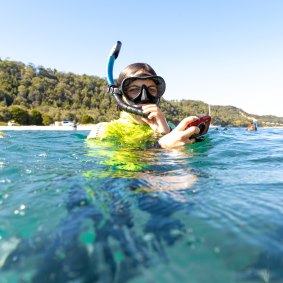
Off-shore exploring at Moreton island.
From along the beach, and even from the resort one kilometre away, the wrecks emerge from the sea like craggy outcrops. Seen up close, they become nothing more than rusted ships, but place your head into the water and they transform into an ocean aquarium garlanded in coral.
At its narrowest point, at low tide, the swim across to the wrecks from the beach can be little more than 100 metres. An hour before low tide, I splash through the low waves breaking on Tangalooma Beach and begin the swim over the sandy seabed. As the water deepens into a seemingly lifeless blue void, there’s little hint of the magnificence to come.
The most prominent wrecks, and those closest to shore, are at the southern end. As I reach the southernmost ship, I’m suddenly immersed in a swirl of sea life. The rusted hull of the wreck rises out of the seabed like a steel cliff, coated in blooms of coral.
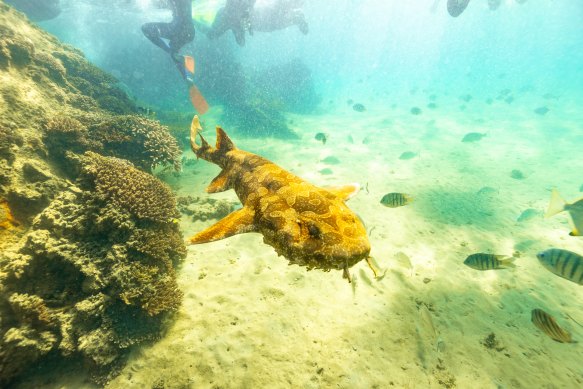
The wrecks are a haven for marine life.
About 100 fish species are said to inhabit the wrecks, with infrequent sightings of dolphins, dugongs and, most enticingly, green sea turtles. Moreton Bay is home to five of the planet’s seven turtle species, and is one of the closest places to any major world city where large populations of turtles can be seen.
As I kick north along the line of wrecks, butterfly fish glide around me, and a pair of lionfish hover above the coral, their fins fanned out in characteristic fashion, but for the moment there are no turtles. I drift with the current along the inside edge of the ships, detouring over decks and into the rusted hulls, where fish burst out of the darkness at rocket-like speed. As I swim over the deck of one wreck, a wobbegong shark moves stealthily beneath me, disappearing into the metal ribcage of the ship.
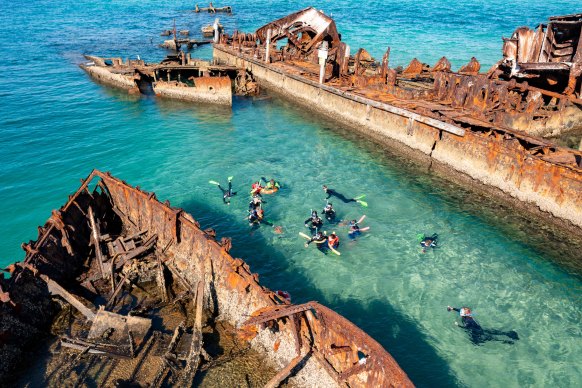
Getting wrecked with a snorkle.
Back on the beach, 4WDs are lined along the sand as though watching a country footy match rather than a marine spectacle. In the opposite direction, across Moreton Bay, the distinctive peaks of the Glass House Mountains stand along the horizon.
For two days, I continue this pattern of returning to the wrecks each low and high tide, when the current is at its most gentle. As I wash in and out of the sea in my wetsuit and fins, ocean life continues to whirl around me. Only on my last swim, moments before reboarding the ferry back to Brisbane, does a green sea turtle finally drift out from beneath a coral bommie.
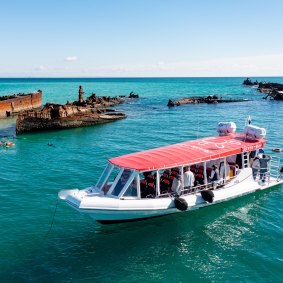
Ferry to the snorkle site.
For a couple of minutes, the turtle floats beneath me before rising to the surface for breath. For a moment, we’re eye to eye, with just a metre of water between us, and then it silently slips away again, leaving me alone in a crowd of fish. Getting wrecked has never felt so good.
THE DETAILS
Micat ferries travel between Brisbane and Moreton Island, docking beside the wrecks, up to three times daily. Australian Sunset Safaris hires out snorkelling gear from a truck on the beach, while Tangalooma Island Resort runs snorkelling tours of the wrecks (and also hires out gear), starting from $69. See moretonislandadventures.com.au/micat-moreton-island-ferry; sunsetsafaris.com.au; tangalooma.com
The writer travelled at his own expense.
Find great Queensland holiday deals at MyQueenslandHoliday.com
Sign up for the Traveller Deals newsletter
Get exclusive travel deals delivered straight to your inbox. Sign up now.